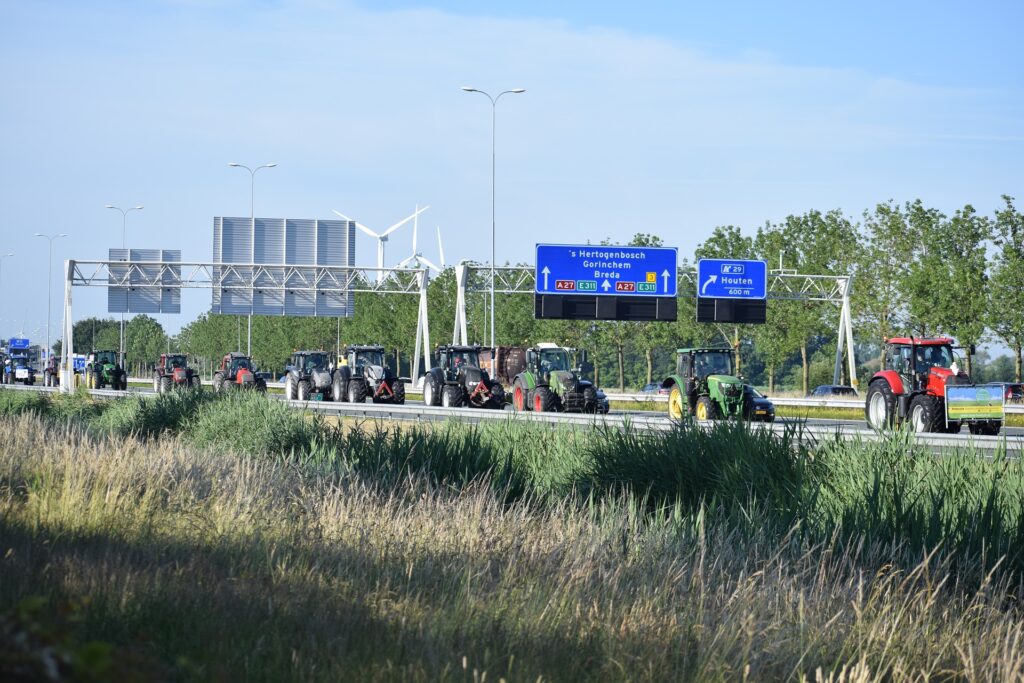
In the webinar on “Sustainable Food Systems: how could Japan and the Netherlands create this?” organized by DUJAT, fantastic speakers from Norinchukin Bank Europe, Oost NL, Rabobank and EY-Parthenon have elaborated on the contemporary situation regarding the Dutch nitrogen crisis. This article describes the main takeaways of the nitrogen crisis, reducing the livestock, and the journey into protein alternatives based on Japan-Dutch relationships and opportunities.
Introduction
The Dutch government wants to reduce emissions by 50% by 2030 due to the alarming nitrogen levels. These regulations are mainly aimed at cattle farmers since the emission of ammonia is the biggest issue in the scope of tackling the nitrogen crisis. This plan as unveiled on June 10, angers farmers and farmer organisations such as the Farmers’ Defence Force (FDF) as seen in demonstrations, blockades of supermarkets and other parts of the food chain, and road blockages. In early July, these activities resulted in a state of emergency in the municipalities of Apeldoorn and Harderwijk.
To stop the societal unrest, the government aimed to get together with the farmers and related organisations to resolve the issues and negotiate the plan. However, the negotiation led by old-minister Remkes, made it clear on the 5th of October that the coalition is not willing to adjust the measurements and stick to the 50% nitrogen reduction by 2030. The only change is that the map used to determine nitrogen emissions gets dropped.
Nitrogen
The alarming levels of nitrogen in the Netherlands have resulted in the nitrogen crisis. However, nitrogen as an element is not particularly harmful to the environment. The compounds NOx (Nitrogen oxides) and NH3 (Ammonia) are the main culprits of harmful nitrogen diffusion. Whereas nitrogen oxides are created in industrial emissions, ammonia can be found in livestock farming. The latter is the most present method of nitrogen emission. Looking into this research, three concepts need to be taken into account: 1) emission: how to get into the air, 2) concentration: the percentage of ammonia in the air, and 3) deposition: how this concentration manifests on the ground.
Dutch Government
Nature2000, a European network of protected nature areas, showcases that 74% of the Dutch sites exceed nitrogen values. In Europe, the loss of biodiversity in nature2000 areas is evident. However, high concentrations of livestock farmers in the Netherlands, Belgium and England emphasise the red zones of nitrogen contamination in the soil (deposition).
In response to the nitrogen crisis, the Nitrogen Reduction Targets assure a need for permits for further construction or development of farming activities. Whereas 30% of the livestock needs to disappear by 2030, there are more options to consider. Firstly, the government aims at buying out the farmers to accomplish these goals. Secondly, the farmers can completely relocate their business to either non-polluted nitrogen areas or across the border where more lenient regulations are evident (e.g. Germany). Lastly, the farmers can invest in sustainable farming to limit their nitrogen emissions. In total, the government reserved 24 billion to realise the objectives.
Alternative protein
Investing in alternative protein is one manner to limit and decrease the need for livestock farming. In the current beneficial research environment, the Dutch government backs certain research in the public-private relationship and encourages initiatives. There is an increased level of business support and climate as seen in the initiative of The Protein Community (TPC).
Four types of innovative protein alternatives can be identified:
- Plant-based proteins.
Plant-based proteins have been established in the Netherlands with brands such as Vivera. This meat substitute can be created from vegetables such for example peas, beans, and greens but also nuts and seeds. The Dutch consumer is familiar with these brands and protein resources.
- Fermentation-based proteins
This type of protein is the usage of microorganisms that reproduce through the process of fermentation as ingredients for alternative proteins. An example is using algae to make fermentation-based protein. While this sector is new and scale-ups are common, collaboration with the big culture is not unusual.
- Cell-culture proteins
The factory-produced protein is remarkable in the method of “printing meat”. Using a controlled condition where protein cells can grow, manufacturers worldwide are racing to create culture proteins that are identical in taste, texture, and nutrition to animal-based protein. In the Netherlands, Mosa meat is the innovator in this fairly new product type.
- Insect-based proteins
The insect counterpart to meat consumption is a normalized part of the diet in Asian countries. However, crickets or other insects yield high protein and can be used in a variety of protein powders or high-energy products. Consumers in the Netherlands are not used to insect-based protein and might need years to fully develop to be part of ordinary life.
Conclusion
With 24 billion available to tackle the nitrogen crisis, the Dutch government is determined to cut nitrogen emissions by 50% and livestock by 30% in 2030. Farmers and the Dutch government have tried to negotiate the approach and measurements but remained almost identical. Options for farmers entail being bought out, relocating or investing (more) into sustainable farming solutions. Knowing the societal pressure to reduce nitrogen emissions, investment and further development into sustainable protein alternatives can resolve the decrease in livestock farming. For more information about Japanese pioneers in the field of alternative protein, we kindly refer you to DUJAT to assist you optimally.
